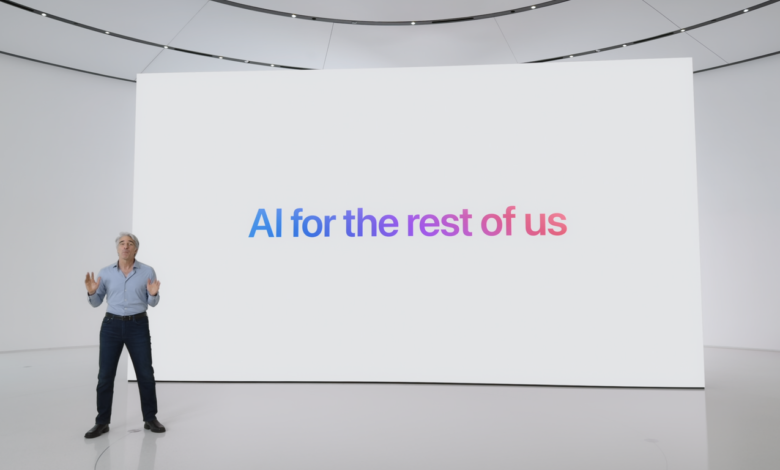Apple unveils “Apple Intelligence,” the iPhone maker’s version of AI for all its products

Apple software executive Craig Federighi. Screenshot: Apple video
Apple on Monday unveiled “Apple Intelligence,” its plan to harness advances in artificial intelligence to improve the software that powers the iPhone, Mac and other products.
Why it matters: Apple has been the slowest of the major tech companies to detail a generative AI strategy, and today’s announcements represent its broadest effort yet to hang the banner of modern AI over its popular products.
Driving the news: Here’s what Apple announced at its Worldwide Developers’ Conference, in a pre-recorded video laying out a roadmap for all its products over the next year.
AI
With “Apple Intelligence,” the company is stressing the highly personal nature of its approach as well as the efforts Apple has taken to preserve privacy, including handling as much work as possible on device.
- Even when it needs to use the cloud, Apple says it can maintain privacy using what it calls “private cloud compute,” drawing on servers running on Apple chips and without letting Apple or others store the data.
- “This sets a brand new standard for privacy and AI,” software executive Craig Federighi said during the taped keynote.
As far as new features, Apple is using generative AI to improve Siri, offer writing tips and create images.
- Apple is also using AI within mail to sort and summarize messages.
- Under the hood, Apple and other developers will be able to define specific actions their apps can take, known as “app intents.” That lays the groundwork for the more powerful Siri assistant.
- Apple Intelligence will arrive later this year as part of coming operating system updates to the iPhone, iPad and Mac, but early adopters will be able to try out an early version starting this summer, Apple said.
In one example, Apple showed the AI feature answering “when does my mom’s flight land?” by drawing upon various pieces of knowledge across the system within multiple apps.
- A new AI-assisted focus mode called “reduce interruptions” selectively surfaces possibly important notifications while silencing most others.
- On the lighter side, Apple debuted an “image playground” for using generative AI to create images in various styles as well as the ability to create custom emoji, dubbed “genmoji.”
- A clean-up tool, similar to Google’s magic eraser, allows people to remove unwanted objects from photos, while AI is also allowing for more natural search within a photo library. For example, one can ask for photos of a particular person in a certain outfit.
- All of the “Apple Intelligence” features, both the ones that run on-device and those that rely on Apple data centers — use Apple-developed models, Axios has confirmed.
For requests that require understanding of the broader world, Apple announced it will work with others, starting with OpenAI.
- Apple said its customers will have free access to ChatGPT without needing to create an account, while subscribers to OpenAI’s paid service will have access to a wider range of features.
- For especially challenging queries, Siri will ask users if they’d rather get a response from ChatGPT.
- Apple said it will protect user privacy by obscuring IP addresses and OpenAI won’t store users’ requests — but ChatGPT’s data-use policies apply for users who choose to connect their accounts.
iOS 18
- The new version of the software that powers the iPhone will allow greater customization, including the ability to place apps and widgets outside of the standard grid.
- Messages will be more customizable, including the ability to schedule a message, reply quickly with any emoji or add text effects.
- And while it got just the briefest of mentions, Apple is finally supporting the RCS standard, which will allow better sharing of photos and video when messaging with Android and other non-Apple devices.
- Apple will also now allow you to send messages via satellite when cellular connectivity is not available.
- The Photos app is getting a makeover to make it easier to manage large collections and avoid seeing unwanted content, like screenshots and receipts.
MacOS Sequoia
- The updated software for Apple’s computers will let users mirror and control an iPhone from the Mac, as well as receive notifications from the phone when it isn’t handy. The phone itself stays locked throughout.
- Sequoia, the new MacOS, also brings a new standalone passwords app, which is also coming to other devices, including the iPhone and iPad.
- The Safari browser will now create highlights from Web pages — including summaries — using machine learning.
iPadOS
- The next version of the iOS variant specifically tailored for Apple’s tablets will get the ability to be remotely controlled plus a calculator app that can solve handwritten equations, a feature also available in the notes app.
- Notes will also get improved handwriting features, such as the ability to both mimic one’s written style for pasted notes as well as to straighten and make more legible one’s own handwritten text.
WatchOS 11
- The updated software that powers Apple Watch will gain new features for language translation, tracking pregnancy and checking-in with friends when the user in a potentially dicey situation, such as taking a late-night run.
VisionOS 2
- Apple began the event by announcing modest updates to the software that powers its Vision Pro headset, including the ability to use larger virtual windows and create spatial images from standard digital photos.



